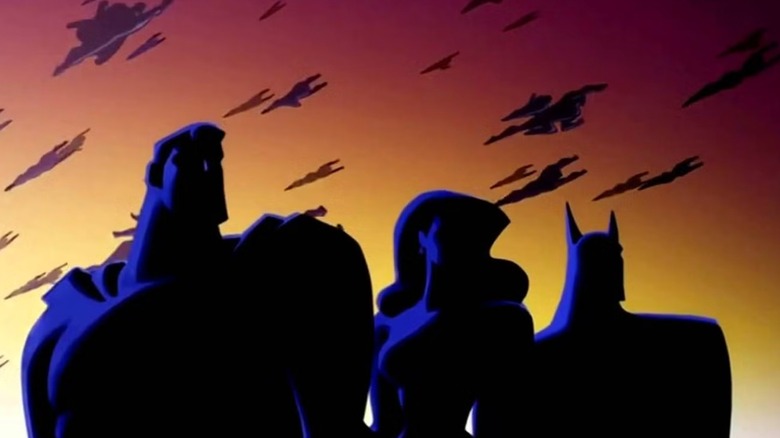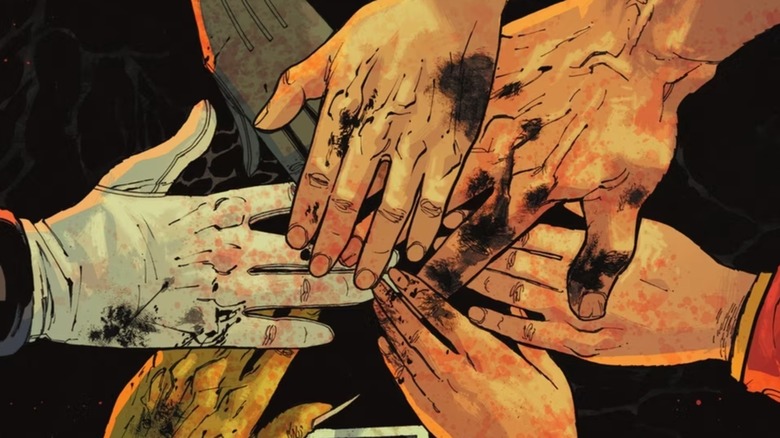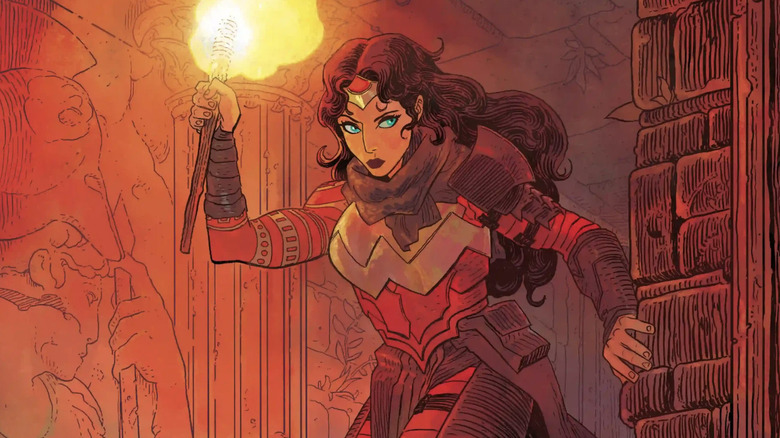DC's Absolute Universe Debuted A Justice League No One Expected
DC's Absolute Universe has thus far kept its heroes siloed off from each other, which is one reason every series feels so unique and the Absolute publishing initiative has been such a success. The books do share a common setting though, and it was only a matter of time before crossovers happened.
"Absolute Batman" and "Absolute Wonder Woman" will be the first crossover this December, when Bruce and Diana team up for a two-part adventure. Is this the first step towards the Absolute Justice League? The heroes may well pool their resources as a team, but as of now, the name "Justice League" is taken.
The new one-shot "Absolute Evil" #1 (written by Al Ewing, drawn by Giuseppe Camuncoli) features a meeting between the main villains of five "Absolute" books: the Joker ("Absolute Batman"), Veronica Cale ("Absolute Wonder Woman"), Ra's al Ghul ("Absolute Superman"), Elenore Thawne ("Absolute Flash"), and Hector Hammond ("Absolute Green Lantern").
The Absolute Universe is a dystopia where these villains are all in positions of Earth-moving power. Cale is the U.S. Secretary of Defense, Joker, Ra's al Ghul and Hammond are all business titans, and Thawne is a black-ops weapons researcher. That's not a symptom of a corrupted system, it's the intended result of one rotten to its core. The five villains understand that the world is working the way it always has, and it's their duty to protect it.
The problem, though, is that too many "monsters" are popping up at once. Left unfettered, they'll inspire others to think a better, freer, and more equal world is possible. To have a hope of vanquishing hope, these power players will have to combine their resources.
Since the laws and power of this world are on the side of evil, it only makes sense that these villains choose to call their alliance the Justice League.
In Absolute DC, it's the villains who form the Justice League
During "Absolute Evil" #1, Cale reviews history with her allies. In this world, the "Golden Age" DC heroes had their vigilante careers nipped in the bud. Wesley Dodds/the Sandman was assassinated and his chemistry advances stolen to make bioweapons, while Ted Grant/Wildcat was bribed to give up his costumed career. Cale continues that tradition when her enforcer Hawkman kills Oliver Queen, the billionaire hero Green Arrow, and throws his body on their meeting table.
"If spoiled little anarchists like the late Mr. Queen here would stand against [the natural] order... that, I call injustice," the Joker says right before he names his fellow oligarchs the world's Justice League. To hammer in how topsy-turvy this all is, their meeting is being held in the Hall of Justice.
The Joker declares that God is on the Justice League's side... and the terrifying thing is, he's right. The Absolute Universe was created by Darkseid, the god of tyranny and evil. On a molecular level, this world is predisposed to favor oppression, brutality, and evil over good. Trying to make a kinder world is going against its laws, which is why the Justice League's goal is to protect against that change. It's the same logic as those in real life who say survival of the fittest is the nature of humanity and reality; if you're on the top or bottom of that system, you deserve to be there.
The villains of Absolute DC have all the resources, and the heroes have none of them. This Batman comes from a working class background, Superman is a fugitive, and Wonder Woman was raised in Hell apart from her Amazon sisters. This is an essential twist to making the Absolute Universe resonate; the world right now isn't working for most people, so the heroes for the moment work in the shadows against power structures.
The heroes of Absolute DC all fight against the system
Scott Snyder, writer of "Absolute Batman," has said that the difference between Absolute Batman and the classic one is that while Batman has traditionally stood for order, the Absolute Batman represents chaos (because he's fighting outside a corrupt order). This is a world that favors evil men like the Joker, so the Joker sits at the top of it. In "Absolute Batman" #5, Joker's henchman Black Mask offered Bruce $200 million to look the other way as Gotham burns — and Batman rejected it. "Absolute Evil" #1 contrasts that decision, which most unsettles the Joker, with Wildcat happily taking the money.
In "Absolute Superman," writer Jason Aaron takes Kal-El back to his 1930s roots as a champion of the oppressed. This Superman travels the world, sabotaging the works of Ra's al Ghul's corporation Lazarus Corp, and encouraging the workers to rise up against their oppressors.
While "Absolute Batman" #1 was published first, Wonder Woman was the first hero to debut chronologically, because she is the brightest light in this darkness. While Absolute Superman and Batman are rougher around the edges, Diana remains an ambassador of peace and kindness. She may be a witch who hails from Hell and rides a skeletal Pegasus, but she's gentle and sees value in all life. Her first instinct has always been to spare her enemies and choose to believe they will be better, even as every other force in the world tells them not to be.
Wonder Woman's cultural reputation has become that of a sword-wielding warrior; some modern comics even characterize her as the most brutal of the DC Trinity. "Absolute Wonder Woman" (written by Kelly Thompson, drawn primarily by Hayden Sherman) understands Diana is really the most messianic of the three. Against her kind heart, I think even this Justice League will fall.
"Absolute Evil" #1 is available to purchase.


